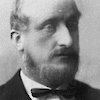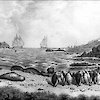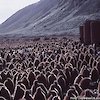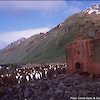Seeing things differently
Tasmania had assumed that Macquarie Island came under its jurisdiction since 1825, when responsibility had passed from the government of New South Wales. But in 1890 the government of New Zealand made a claim to sovereignty by right of its much more active involvement in sealing there. The dispute was settled in Tasmania’s favour.
By the 1890s an emerging mineral oil industry was beginning to bite into the profits of the animal industry, but a New Zealander named Joseph Hatch decided to give Macquarie Island one last go. He secured a Tasmanian permit to exploit, not the seals, but the island’s much more numerous penguins.
Hatch’s highly-organised multi-year operation involved extensive penguin marshalling yards and processing facilities at various points around the island, including the Nuggets, Lusitania Bay, the Isthmus and Hurd Point. He shipped coal and firewood to the island to keep the ‘digestors’ operating continuously during the penguins’ summer breeding months.
Scientists had visited the island as early as 1820 with the Russian Antarctic explorer Bellingshausen, then in the late 1830s with the US navigator Charles Wilkes. Wilkes published his account of the Antarctic voyages and visit to Macquarie Island in Narrative of the United States Exploring Expedition: during the years 1838, 1839, 1840, 1841, 1842 [PDF].
Two New Zealand scientists, JH Scott and A Hamilton, visited the island in 1879 and 1894 respectively, and Joseph Burton collected specimens over three and a half years from 1896 working with oiling parties. Scientists with Antarctic expeditions — the 1901 Scott Discovery and Shackleton’s 1909 Nimrod and 1915 Aurora parties – also spent time ashore collecting specimens.
The 1911–1914 stay on the island by the AAE men was a turning point. Mawson’s personal repulsion at the penguin slaughter by Hatch’s men, backed up by the AAE’s meticulous recording of the island’s climate, geography, geology and biology, gave outsiders a different perspective on Macquarie Island. Within a decade Hatch was gone, and in 1933 the Tasmanian government declared the island a wildlife sanctuary.





